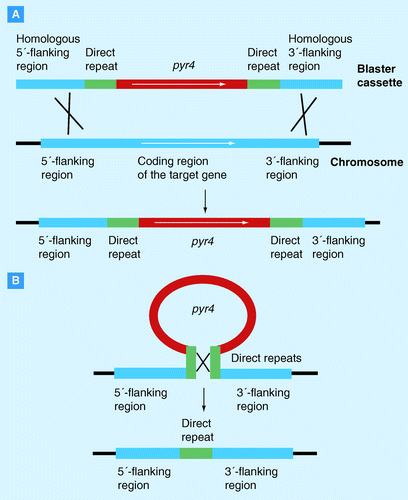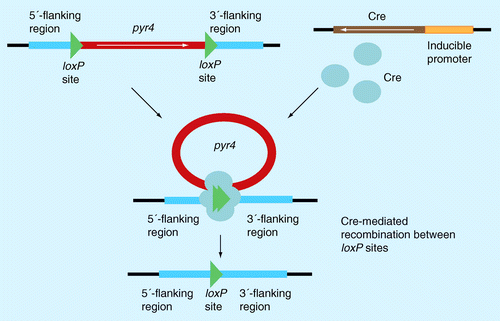Figures & data
(A) The blaster cassette is composed of a genetic marker ( T. reesei pyr4) flanked by two direct repeats of any sequence and homologous flanking regions of the target gene. By homologous recombination this blaster cassette replaces the coding region of the target gene in the fungal chromosome. The respective strain is now uridine prototrophic. (B) To select for the excision of the blaster cassette the transformed strains are grown in the presence of 5-fluoroorotic acid and uridine. Homologous recombination between the two direct repeats eliminates the marker gene and one direct repeat from the chromosome. The resulting strain is therefore resistant against 5-fluoroorotic acid and uridine auxotrophic, which allows a new round of genetic transformation.

Similar to the blaster cassette-mediated gene deletion the target gene was replaced by homologous recombination by the pyr4 marker. In this case, the pyr4 gene is flanked by two loxP sites. In addition, a Cre recombinase expressed under an inducible promoter was introduced into the genome. The expressed Cre recombinase assembles at each loxP site as a dimer and induces recombination between loxP sites as a tetramer. Upon successful excision of the pyr4 marker, the resulting strain is again uridine auxotrophic.

(A) Formation of stromata (fruiting bodies) occurs when fungal strains of opposite mating types are grown on agar plates. (B) Into the upper surface of the stromata perithecia are embedded, which can be seen macroscopically as dark brown dots. (C) Perithecia have the shape of a round bodied bottle. (D) contain asci, which are tube-like structures containing 16 sexual spores (ascospores).
